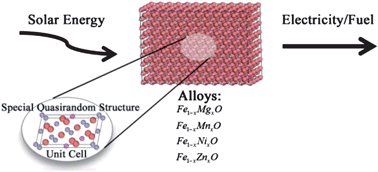Although calculating the likelihood that the Sun will rise tomorrow is far from trivial, solar power remains an extremely promising source of sustainable energy. Widespread adoption of current-generation photovoltaics (PV) is held back by low efficiency and the high cost of manufacturing the necessary single-crystal silicon. Inexpensive, naturally occurring transition metal oxides (TMOs) such as iron(II) oxide, manganese(II) oxide and nickel(II) oxide would be cost-effective but they currently suffer from extremely low efficiency.
Toroker and Carter recently attempted to tackle this problem using a computational approach. They simulated the effect that combining different TMOs would have on their usefulness in PV applications. They considered four key properties: band gap, the type of states at band edges, the band edge positions and the band gap centre (BGC) offset – a new metric proposed by the authors. Through the simulations, they found it was possible to prepare more useful materials when using combinations of TMOs. For example, the band gaps of MgO, MnO, NiO and ZnO – which are normally too high to absorb solar energy – could be reduced in an alloy formed with FeO.
Their calculations suggest that an alloy of 3:1 NiO:FeO would satisfy all their criteria for a useful PV. They suggest that the next step in the process is to devise a strategy for doping to improve conductivity.
Transition metal oxide alloys as potential solar energy conversion materials
J. Mater. Chem. A, 2013, 1, 2474. DOI:10.1039/C2TA00816E
James Serginson is a guest web writer for the Journal of Materials Chemistry blog. He currently works at Imperial College London carrying out research into nanocomposites.
To keep up-to-date with all the latest research, sign-up to our RSS feed or Table of contents alert.











